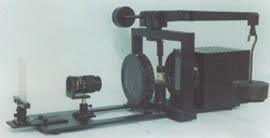|
The photoelastic model is made by transparent material that can generate double refraction under external force. The interference fringes, which react the difference of principle stresses can be observed in the polarized light field under simulated loading conditions, are relative to the stress distribution of the photoelastic model. Technologies of photoelastic effect can help us understand the full field stress distribution, direction of principle stress, stress concentration point, stress value of each point, and boundary stresses.
Three-dimensional models, which can also be made by the same material, are heated to the freezing temperatures with simulated loading conditions. Double refraction fringes that relevant to the stress distributions of the model sections can then be observed in the polarized light field. This is entitled as three-dimensional freezing photoelasticity. Applications of the model are unlimited to the complexity of object shapes such as motor body and cylinder head. Photoelastic coating method can be directly applied to the objects that are not transparent for stress measurement. Transient variation and stresses distribution under impulse loading, such as shock or blast wave, can also be recorded with satin camera.
|
 |